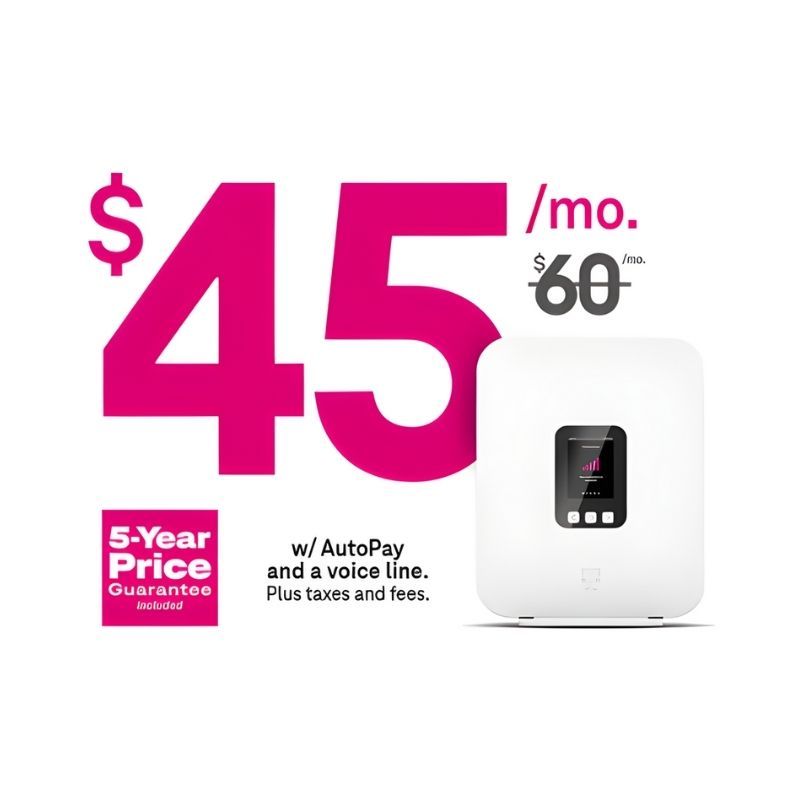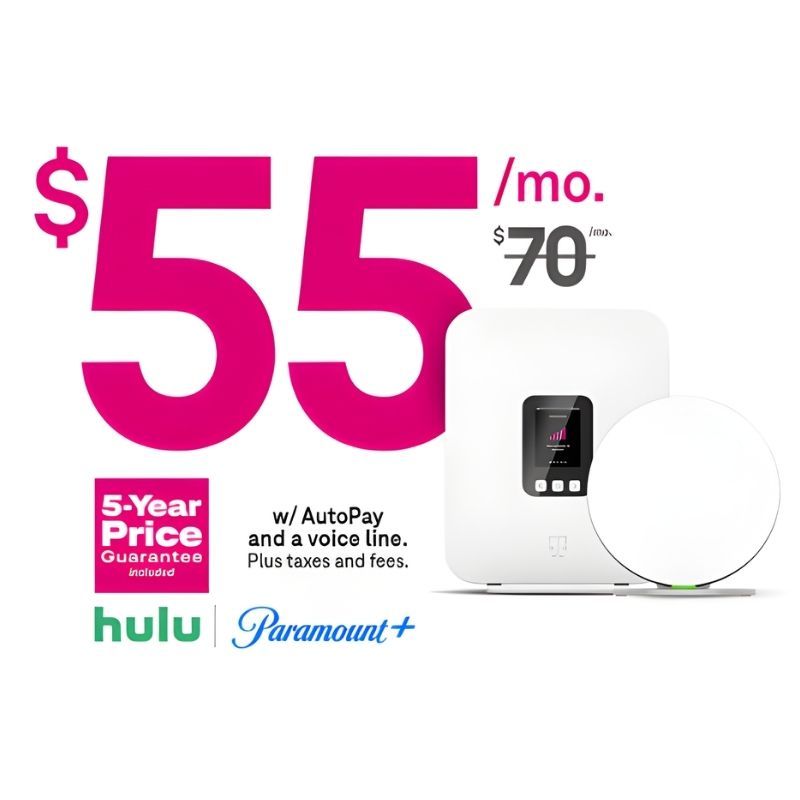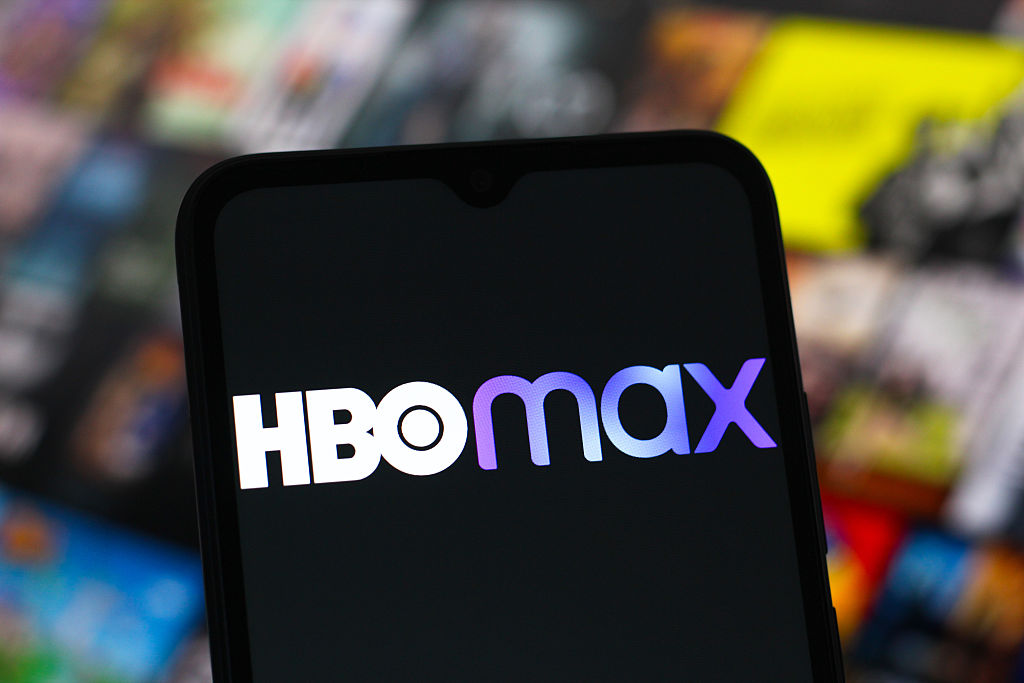Is Wireless Home Internet Right for You?
Could T-Mobile’s affordable, no-fuss home internet be the everyday upgrade you’ve been waiting for? Here’s what to know before you sign up.


For decades, getting home internet meant scheduling a technician, drilling holes, running cables and setting up a bulky modem. But that model is changing fast.
Carriers such as T-Mobile and Verizon are betting that wireless home internet, powered by the same 5G networks that run your smartphone, can deliver reliable broadband without the wires, contracts or hidden fees that frustrate customers.
T-Mobile’s 5G Home Internet is catching on with households that want an easier setup, fewer devices to manage and a lower monthly bill. If you’re looking to simplify your home internet without scheduling an install or dealing with extra equipment, here’s what to know before signing up.
From just $107.88 $24.99 for Kiplinger Personal Finance
Become a smarter, better informed investor. Subscribe from just $107.88 $24.99, plus get up to 4 Special Issues

Sign up for Kiplinger’s Free Newsletters
Profit and prosper with the best of expert advice on investing, taxes, retirement, personal finance and more - straight to your e-mail.
Profit and prosper with the best of expert advice - straight to your e-mail.
How wireless home internet works
Wireless home internet delivers broadband through the same cellular towers that serve mobile phones. Instead of using coaxial cables or fiber-optic lines, a home router (often called a gateway) connects to a nearby cell tower and broadcasts Wi-Fi throughout your home.
It’s different from tethering your phone or using a mobile hotspot. Wireless gateways are built for stationary whole-home use with larger antennas and stronger receivers. You can stream, browse or video chat much such as you would on a cable or fiber connection, although speeds can vary based on your distance from the tower and the strength of your carrier’s network.
The technology, known as fixed wireless access, is growing quickly as carriers such as T-Mobile, Verizon and AT&T expand their coverage.
What to expect from T-Mobile 5G Home Internet
T-Mobile delivers home internet over its nationwide 5G and 4G LTE network and setup is straightforward. Plug in the gateway (included with the plan), download the T-Mobile Internet app and follow the steps. There’s no technician visit, special wiring or installation fee and most customers can be online in minutes.
The service typically costs $50 to $70 per month without a voice line. Customers who bundle with an eligible T-Mobile phone plan save $15 a month, bringing the cost down to $35 to $55 monthly. The price includes equipment, taxes and fees. T-Mobile’s 5-Year Price Lock Guarantee means your rate won’t increase for at least five years, and there is no long-term contract required.
Typical download speeds range from 134 Mbps to 415 Mbps, while upload speeds run from 12 Mbps to 55 Mbps. T-Mobile notes that about 25% of customers see speeds below or above these ranges depending on location and network conditions. Those speeds are sufficient for HD streaming, video calls and everyday internet browsing.
T-Mobile offers several home internet plans that bundle internet service with a T-Mobile voice line. Prices vary by plan tier and perks.

RELY
T-Mobile 5G Internet Plan
- Reliable, affordable home internet with fast speeds
- $35 per month with AutoPay and a voice line, plus taxes and fees
- Get $100 back via a virtual prepaid card within 14 weeks.

AMPLIFIED
T-Mobile 5G Internet Plan
- $45 per month with AutoPay and a voice line, plus taxes and fees
- Advanced Cyber Security
- 24/7 Tech Support
- Get $200 back via a virtual prepaid card within 14 weeks

All-IN
T-Mobile 5G Internet Plan
- $55 per month with AutoPay and a voice line, plus taxes and fees
- Advanced Cyber Security
- 24/7 Tech Support
- Streaming perks: Hulu (with Ads) and Paramount+ Essential Plan included with All‑In Home Internet.
- Mesh Wi-Fi extender
- Get $200 back via a virtual prepaid card within 14 weeks.
Weighing simplicity against performance
As with most things, it’s important to weigh the pros and cons and think about what fits your lifestyle. Here are some advantages to consider.
Ease of setup
One of the biggest benefits is convenience. You can install it yourself without an appointment or special equipment. The all-in-one gateway, which is included with your plan, replaces both a modem and router, and the app helps you find the best spot in your home for signal strength. There’s no drilling or wiring, which makes it a good option for renters.
Transparent pricing
T-Mobile’s flat monthly rate covers everything with no rental fees or surcharges.
Cost savings
Many households can save $20 to $50 a month compared with traditional broadband, especially when bundling with an existing T-Mobile phone plan.
Portability
If you move within a covered area, you can take the gateway with you. That kind of portability is especially helpful for renters, college students and snowbirds, or anyone who relocates frequently.
Variable speeds and reliability
Despite its benefits, wireless home internet isn’t a perfect fit for everyone. Here are some potential drawbacks to keep in mind.
Speed fluctuations
Because it relies on cell towers, performance can vary based on your location, signal strength and network congestion. During peak hours, you might notice slower speeds.
Data prioritization
In congested areas, mobile carriers might prioritize smartphone traffic over home internet users. Your connection could slow temporarily when the network is busy.
Coverage limitations
Not all addresses qualify for service, and rural customers might still connect through 4G LTE instead of full 5G speeds. Always check coverage maps and test the service before canceling your existing provider.
Internet options at a glance

When comparing home internet services, the best choice depends on your needs, budget and location. Here’s how the main internet service options stack up at a glance.
Feature | T-Mobile 5G Wireless | Cable Internet | Fiber Internet |
Download speed range | 133 to 415 Mbps | 10Mbps to 1 Gbps | 200 Mbps to 20 Gbps |
Upload speed | 12 to 55 Mbps | 5 to 50 Mbps | 200 Mbps to 20 Gbps |
Installation | Plug - and - play | Technician required | Technician required |
Contracts | None | 12 – 24 months | 12 – 24 months |
Monthly cost | $35 – $55 w/ Voice Line and AutoPay | $50 – $120 | $70 – $150 |
Best for | Everyday browsing, email, streaming and video calls | Large families, households with multiple smart devices, moderate streaming and gaming | Lots of connected devices, heavy streaming and remote work requiring fast and reliable uploads. |
Fiber remains the gold standard for speed and reliability, but it’s expensive and not widely available.
While cable is more consistent than wireless, it often comes with contracts and fees. Wireless home internet wins on simplicity and value, especially for simple everyday internet use.
Who should consider wireless home internet?
Wireless home internet makes sense for:
- Renters or households tired of contracts and fees
- Families with moderate streaming and browsing needs
- People who move frequently or live in strong 5G coverage areas
- Rural customers with limited broadband or fiber options
On the other hand, if you upload large files, work in data-intensive fields or you're heavily into gaming or cloud computing, fiber might be the better long-term choice if available.
Making the right choice for your home
T-Mobile’s 5G Home Internet offers an appealing blend of affordability, convenience and coverage. It could be a strong alternative for those seeking to simplify their bills without sacrificing too much speed. It’s not perfect, but it’s fast becoming a competitor to traditional broadband.
Related Content
Profit and prosper with the best of Kiplinger's advice on investing, taxes, retirement, personal finance and much more. Delivered daily. Enter your email in the box and click Sign Me Up.

Carla Ayers joined Kiplinger in 2024 as the eCommerce and Personal Finance Editor. Her professional background spans both commercial and residential real estate, enriching her writing with firsthand industry insights.
Carla has worked as a personal finance and real estate writer for Rocket Mortgage, Inman and other industry publications.
She is passionate about making complex real estate and financial topics accessible to all readers. Dedicated to transparency and clarity, her ultimate goal is to help her audience make informed and confident decisions in their financial pursuits.
-
 New IRS Changes to FSA Contribution Limits for 2026: What to Know
New IRS Changes to FSA Contribution Limits for 2026: What to KnowHealth Care Flexible Spending Accounts have tax advantages worth looking into, especially in light of new IRS changes.
-
 QUIZ: What Type Of Retirement Saver Are You?
QUIZ: What Type Of Retirement Saver Are You?Quiz What is your retirement savings style? Find out with this quick quiz.
-
 Meet the World's Unluckiest — and Entitled — Porch Pirate
Meet the World's Unluckiest — and Entitled — Porch PirateThis teen swiped a booby-trapped package that showered him with glitter, and then he hurt his wrist while fleeing. This is why no lawyer will represent him.
-
 11 Cities With the Cheapest Groceries in the US
11 Cities With the Cheapest Groceries in the USIf you live in one of these 11 cities, you're paying less than the rest of the country to keep your fridge stocked.
-
 NordVPN’s Huge 77% Black Friday Discount Is One of the Top VPN Deals We’ve Seen This Year
NordVPN’s Huge 77% Black Friday Discount Is One of the Top VPN Deals We’ve Seen This YearSave up to 77% on NordVPN with this Black Friday deal, a practical choice for improving online security and streaming access.
-
 How to Get HBO Max for $2.99 with Hulu This Black Friday
How to Get HBO Max for $2.99 with Hulu This Black FridayTake advantage of Hulu’s holiday pricing and stream HBO Max hits for only $2.99 a month.
-
 Hulu’s Black Friday Deal Gets You Starz for Only $2.99
Hulu’s Black Friday Deal Gets You Starz for Only $2.99Get premium entertainment for less with Hulu’s limited-time Black Friday STARZ deal.
-
 The Best Christmas Movies on Paramount+ (and How to Watch Them for Less)
The Best Christmas Movies on Paramount+ (and How to Watch Them for Less)Settle in this holiday season with classic Christmas movies on Paramount+ and save with the service’s limited-time Black Friday deal.
-
 Is Verizon’s 5G Home Internet Right for You?
Is Verizon’s 5G Home Internet Right for You?A look at pricing, perks and who gets the most value from Verizon’s home internet plans.
-
 Why You Might Want to Keep Your Phone Instead of Trading It In
Why You Might Want to Keep Your Phone Instead of Trading It InUpgrading your phone doesn’t have to mean handing over the one you already use.
-
 6 Quick Money Moves to Make Before the Year Ends
6 Quick Money Moves to Make Before the Year EndsFinish the year strong with smart money moves that can boost savings, trim taxes and set you up for a better 2026.